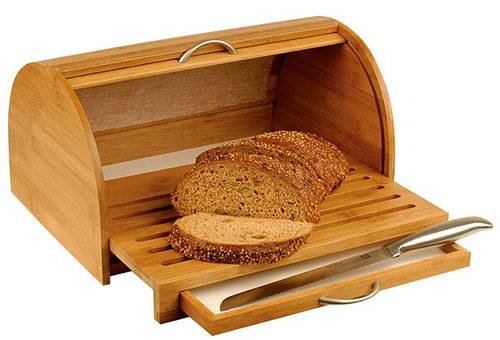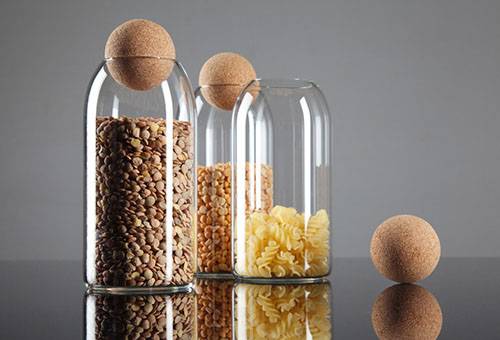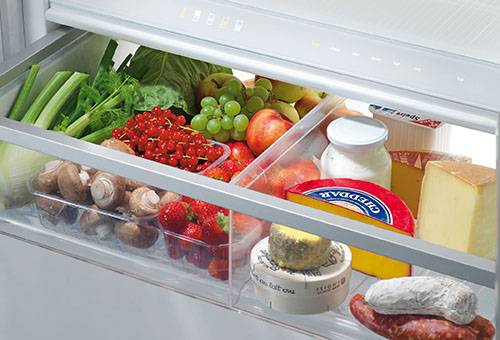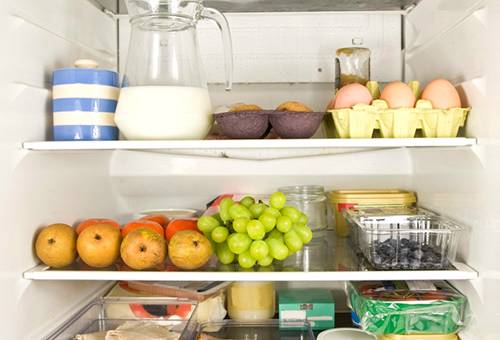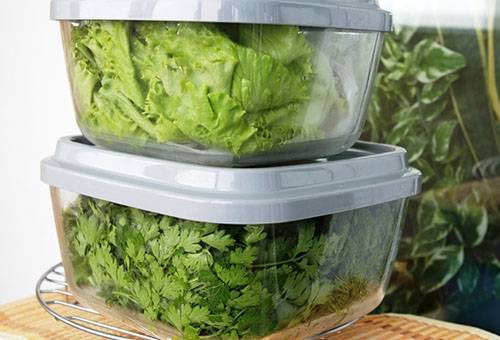How to store food at room temperature and in the refrigerator?
Content:
Every housewife should know how to properly store food. Well, if you have at hand a table with the conditions and terms of validity. But it’s not always possible to look into it, so it’s worth remembering the features of the most commonly used goods: bread, meat, vegetables, cereals, dairy products, sauces and others. They will deteriorate much faster if the necessary measures are not taken.
What foods can be stored at room temperature?
Storage of foods that deteriorate quickly: sausages, dairy products, sauces, is often better organized than dry ones. But they also need to be given enough attention. They have expiration dates, after which useful qualities are lost and an unpleasant smell appears.
- The best place for bread is a wooden unpainted bread box, it should not be near heating appliances or a sink.
The temperature is at least 6 degrees, air is desirable dry, then the product will be edible for up to 5 days. You can leave the factory cellophane packaging, it is equipped with small holes through which air enters. In a simple package, the product “suffocates”, mold will appear on it soon. Polyethylene should be used only if you need to hide the roll in the refrigerator.
- In a sealed bottle, vegetable oils are stored at normal temperature for 4-6 months.
After opening, the product should be placed in the refrigerator, as it will soon oxidize. The more polyunsaturated fatty acids in it, the faster this process goes. This applies, for example, to very healthy linseed oil. Olive thickens in the cold, becomes cloudy. This does not mean that it has deteriorated, at room temperature it will return to normal.
- Cereals best preserve their properties in loosely closed containers or linen bags.
But they are very susceptible to pest infection. Therefore, storage rules for products in this category provide for sealed containers. You should not keep them on the balcony: it’s easier for bugs to get comfortable there, as they can get over from their neighbors. Most cereals can lie up to two years, semolina and corn - 10 months, millet - 9, but oatmeal only 4.
- Pasta is stored in the same way as cereals.
Preference should be given to tightly closed jars in order to protect the product from bugs and larvae. The temperature should not exceed 20 degrees, the humidity is necessary moderate. Egg pasta retain their qualities for up to a year, others for up to two.
- Flour and starch are afraid of high humidity.
They lose their structure, microorganisms start up in them, mold appears. In addition, there is a risk of infection by insects. Flour is stored a little more than six months, and starch - up to two years.
- Salt and sugar also deteriorate under the influence of high humidity.
But thanks to the antiseptic properties, microorganisms and pests will not start in them. Products can only lose flowability. If stored properly, they will remain usable for years.
- Dried fruits begin to darken at temperatures above 20 degrees.
The shelf life is affected by the initial quality of the fruit. Prunes can lie for six months, others - twice as long.
How to store food in the refrigerator?
Storage of food in the refrigerator should be properly organized. The temperature rises from the bottom up. If on a shelf adjacent to the freezer, about 0 degrees, then in another part it can reach up to 8. In modern technology, the freezer is usually located below.So in the compartment above it you need to remove everything that quickly deteriorates.
Often you can find containers for fruits and vegetables over the freezer. But not all of them tolerate such a low temperature well. For example, apples, plums, celery will be well preserved, but cucumbers or berries can freeze, which will change the appearance and taste. They are best placed on the top shelf.
Important!
Near the door, the temperature is higher than in the back of the refrigerator.
Most products feel good on the middle shelves of the refrigerator: these are ready-made dishes, cheese, butter, and a variety of sweets. But the door has an unstable temperature, as the refrigerator is constantly opened. Therefore, it is possible to add to it only that which will not be damaged by such differences. It is suitable for storing drinks, tightly closed sauces, eggs, provided that they will be eaten soon.
The principle of increasing degrees from the bottom up works in the freezer. Therefore, it is better to place fish, frozen vegetables and fruits, oil at the top. Too low a temperature will lead to a violation of the structure and loss of taste. Semi-finished products from the dough also should not be put down, as they will begin to crumble. The lowest compartment is suitable for meat and ice cream.
Terms and conditions of storage
To store foods for as long as possible, they should be properly packaged. Humidity promotes the growth of bacteria, so you need to take measures so that they do not move to food.
Raw foods must be cleaned in plastic containers, glassware or plastic bags. Metal containers are not suitable, as their surface is oxidized in contact with meat or fish, as a result of which toxic substances are released. This also applies to canned food, so they should be shifted from the can.
Only vegetables and fruits can be stored unpacked. But washing them before hiding in the refrigerator is undesirable. It will also lead to increased reproduction rates of microorganisms and rapid spoilage.
Under all conditions, the fish from the refrigerator will be suitable for consumption for 2 days, meat - up to 5, dairy products from 3 days to a week. Do not keep food in the freezer for longer than 3 months. You can eat them after this period, but they will not bring any benefit: vitamins and protein are gradually destroyed at a low temperature. If for some time there was no electricity and the refrigerator managed to defrost, it is impossible to expose the products to re-freezing.
The shelf life of semi-finished products depends on the type of product. This can be various types of dough or products with a shell of dough, such as dumplings and dumplings. At a temperature of about 18 degrees, the shelf life is 2 months.
It is necessary to take care of the cleanliness of the unit. Shelves should be washed monthly. In the fruit compartments it is worth putting a special sponge mat, then there will be additional protection against mold. It is important from time to time to sort through the contents of the refrigerator. Rotten vegetables, expired sauces must be discarded.
Features of some products
Most fruits and vegetables are perfectly stored without a refrigerator. But exotic, for example bananas, at low temperature lose their taste and healthy qualities. But the berries have a very fragile skin that breaks easily. In this case, juice is released, as a result, mold may form the very next day. So they should be put in cardboard boxes with a thin layer and put in the refrigerator.
It is also worth considering that some fruits and vegetables emit ethylene. This gas leads to accelerated ripening. Therefore, apples, bananas, figs, plums, tomatoes must be separated from the rest. You can use the same property so that an unripe fruit ripens faster: put it in one bag with an apple, for example.
In order for the greens to be well preserved, you need to slightly cut the stems and put the plants in the water.Then you can leave it at normal temperature or put in the refrigerator - depending on how soon they go into business. Leafy greens, such as spinach and arugula, are often sold in tightly packed plastic containers in stores. This is not the best way to store products, as they break, fade and change color. To prevent this from happening, it is necessary to transfer the leaves to a vacuum container, after washing and shaking off the water. After that, you need to put it in the refrigerator. You can still cover the greens in the container with a dampened cloth to prevent moisture loss.
Some vegetables are perfectly stored and without a low temperature. So it makes no sense for them to take a seat in the refrigerator. This applies to onions and garlic with their strong shell, potatoes, pumpkins, beets with a dense structure. It is better to organize a drawer in the kitchen.
A feature of nuts and seeds is that they contain a very large amount of fat, which can go rancid if stored improperly. It is best to leave them in the shell for the winter. They can be folded into a container with a well-fitting lid and taken to a dark, cool place. When cleaned, they take up little space and are convenient to use, but are more prone to spoilage. Therefore, they must be in the refrigerator. They can also be frozen.
You need to pay attention to the storage of sauces. Wine sauce in a cool place will not go bad for several years, it will even improve its qualities. After opening, soy sauce and salsa should be refrigerated for up to 1 year. Mayonnaise should also be in the refrigerator, but not more than two months. Place for sauces can be reserved on the door - they are not afraid of temperature changes when opening.
The conditions and shelf life of canned food, as well as other products, are indicated on the label. Usually they have enough normal temperature. But too high will hurt. The products will have a metallic taste. If we are talking about canned fruits, which include preserves and juices, then they will darken. At low temperature - they will be sugared. Particular attention should be paid to preserves - unsterilized canned food. They should be in the refrigerator, at normal temperature, their shelf life is up to 3 days.
Food storage is a task that must be treated responsibly. It is necessary to organize the kitchen space so that the placement of vegetables, fruits, meat, fish, dairy products, sauces is not difficult. A table of necessary conditions and terms for various products will help with this.
